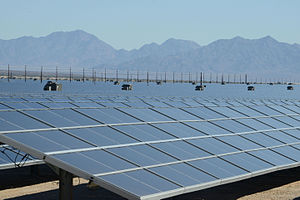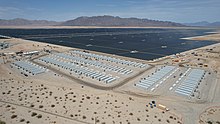Desert Sunlight Solar Farm
| Desert Sunlight Solar Farm | |
|---|---|
 Solar arrays at Desert Sunlight | |
 | |
| Country | United States |
| Location | Riverside County, California |
| Coordinates | 33°49′17″N 115°23′38″W / 33.82139°N 115.39389°W |
| Status | Operational |
| Construction began | 2011 |
| Commission date | 2015 |
| Owners | NextEra Energy Resources, GE Energy Financial Services, Sumitomo Group |
| Solar farm | |
| Type | Flat-panel PV fixed tilt |
| Site area | 3,900 acres (1,600 ha) |
| Power generation | |
| Nameplate capacity | 550 MWAC |
| Capacity factor | 27.5% (average 2015-2018) |
| Annual net output | 1,325 GW·h, 340 MW·h/acre |
| External links | |
| Website | firstsolar.com |
The Desert Sunlight Solar Farm is a 550-megawatt (MWAC) photovoltaic power station approximately six miles north of Desert Center, California, United States, in the Mojave Desert. It uses approximately 8.8 million cadmium telluride modules made by the US thin-film manufacturer First Solar. It has the same 550 MW installed capacity as the Topaz Solar Farm in the Carrizo Plain region of Central California, making both of them tied for the second largest completed solar plants by installed capacity as of fall 2015.[1][2]
Project details
[edit]Project construction took place in two phases, both of which are supported by power purchase agreements.
Phase I has a capacity of 300 MW, which will be sold to Pacific Gas & Electric Company. Phase II has a capacity of 250 MW, which will be sold to Southern California Edison. The project was expected to involve more than 550 construction jobs in Riverside County, California.[3] The project was built on over 6 square miles (16 km2) of creosote bush-dominated desert habitat near Desert Center next to Joshua Tree National Park.[4] Construction began in September 2011 and final completion was in January 2015.[2][5]
The $1.46 billion in loans for the project are partially guaranteed by DOE and will be funded by a group of investors led by Goldman Sachs Lending Partners, which submitted the project under the Financial Institution Partnership Program (FIPP), and Citigroup Global Markets Inc. as co-lead arranger.[3]

A 230 MW and 920 MWh (4-hour) battery storage power station was added in 2022.[6]
Electricity production
[edit]| Year | Total Annual MW·h |
|---|---|
| 2013 | 104,301 |
| 2014 | 1,020,905 |
| 2015 | 1,286,763 |
| 2016 | 1,346,282 |
| 2017 | 1,321,129 |
| 2018 | 1,344,841 |
| Average (2015–2018) | 1,324,754 |
| Year | Jan | Feb | Mar | Apr | May | Jun | Jul | Aug | Sep | Oct | Nov | Dec | Total |
|---|---|---|---|---|---|---|---|---|---|---|---|---|---|
| 2013 | 12,877 | 15,657 | 28,534 | ||||||||||
| 2014 | 21,773 | 27,207 | 34,901 | 41,461 | 39,400 | 43,829 | 51,572 | 39,497 | 46,360 | 46,364 | 46,793 | 34,333 | 473,490 |
| 2015 | 40,399 | 47,894 | 56,371 | 59,569 | 60,775 | 57,715 | 58,348 | 58,787 | 39,097 | 47,562 | 45,791 | 41,633 | 613,941 |
| 2016 | 39,151 | 50,933 | 55,135 | 54,198 | 63,118 | 59,008 | 61,051 | 57,526 | 53,062 | 50,947 | 43,476 | 36,137 | 623,742 |
| 2017 | 25,225 | 28,175 | 52,539 | 55,354 | 69,598 | 75,424 | 68,750 | 63,536 | 59,329 | 54,655 | 33,586 | 32,031 | 618,201 |
| 2018 | 28,722 | 40,501 | 46,310 | 57,894 | 69,784 | 75,188 | 64,990 | 65,442 | 61,950 | 48,809 | 33,573 | 26,709 | 619,921 |
| Year | Jan | Feb | Mar | Apr | May | Jun | Jul | Aug | Sep | Oct | Nov | Dec | Total |
|---|---|---|---|---|---|---|---|---|---|---|---|---|---|
| 2013 | 10,015 | 32,709 | 33,043 | 75,767 | |||||||||
| 2014 | 32,312 | 34,615 | 44,998 | 45,876 | 43,733 | 47,205 | 45,698 | 44,642 | 66,531 | 51,571 | 52,960 | 37,274 | 547,415 |
| 2015 | 45,802 | 52,966 | 60,742 | 64,541 | 61,367 | 63,147 | 63,620 | 63,517 | 44,398 | 53,467 | 51,543 | 47,712 | 672,822 |
| 2016 | 44,903 | 58,492 | 61,875 | 60,223 | 74,220 | 70,241 | 72,661 | 67,907 | 61,623 | 58,041 | 50,542 | 41,812 | 722,540 |
| 2017 | 28,682 | 32,036 | 59,740 | 62,940 | 79,137 | 85,761 | 78,172 | 72,243 | 67,460 | 62,146 | 38,189 | 36,421 | 702,928 |
| 2018 | 33,645 | 47,361 | 54,154 | 67,699 | 81,604 | 87,922 | 75,998 | 76,527 | 72,443 | 57,076 | 39,259 | 31,232 | 724,920 |
Environmental issues
[edit]In 2012 the National Parks Conservation Association issued a report identifying three desert solar power plants sited within five miles of National Parks in the California Desert as projects that they suggest should not have been approved in their locations, including the Desert Sunlight Solar Farm.[9] The NPCA report cites damage and impact to visual resources, and impacts on critical desert species.[10][11]
See also
[edit]References
[edit]- ^ Goldenstein, Taylor ( 9 February 2015) "Huge solar farm opens in California: Enough energy for 160,000 homes" Los Angeles Times.
- ^ a b FirstSolar.com Desert Sunlight Solar Farm
- ^ a b "DOE Closes on Four Major Solar Projects". Renewable Energy World. 30 September 2011. Archived from the original on 11 November 2011. Retrieved 4 October 2011.
- ^ "Desert Sunlight Solar Farm Project". Bureau of Land Management. Archived from the original on 30 November 2011. Retrieved 4 December 2011.
- ^ "Desert Sunlight Solar Farm, Desert Center, california". Powermag.
- ^ Murray, Cameron (17 August 2022). "230MW BESS comes online at Bureau of Land Management site in California". Energy Storage News.
- ^ "Desert Sunlight 250, LLC, Monthly". Electricity Data Browser. Energy Information Administration. Retrieved May 22, 2020.
- ^ "Desert Sunlight 300, LLC, Monthly". Electricity Data Browser. Energy Information Administration. Retrieved May 22, 2020.
- ^ Danelski, David (April 16, 2015). "SOLAR POWER: Inland plants boost state to No. 1". The Press-Enterprise. Riverside, California.
- ^ "Group Calls For Strict Limits on Solar Power Near National Parks". KCET. Archived from the original on 22 November 2012. Retrieved 30 November 2012.
- ^ "Group Calls For Strict Limits on Solar Power Near National Parks". pbs.
